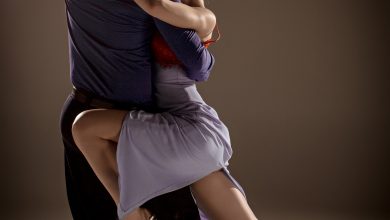The Embrace in Argentine Tango – Part 1

Every move in argentine tango is communicated to the follower by the leader with the help of the embrace so it is extremely important to have a quality embrace. The embrace must communicate the lead so the follower knows how to move and step. The embrace must also simultaneously feel good for the follower.
There are three principal types of embrace: Open Embrace, Close Embrace, and the Practice Embrace. The close embrace is obviously more challenging and more advanced than the open embrace or practice embrace so beginner instruction tends to begin with the practice embrace followed by the open embrace.
Practice Embrace
There are a variety of ways to form a practice embrace depending on the particular move that is being taught. The most common styles are grasping each other’s forearms or biceps. For certain movies, the teach will ask the follower to place their hands on the chest, shoulders, or upper arm of the leader as this is a very good way to teach the leader how to use their chest and embrace to lead rather than relying on their arms and hands. It also teaches the follower to “listen” to the chest rather than the arms and hands.
Open Embrace
Open embrace is also known as salon embrace. Most beginners to argentine tango are initially taught using an open embrace before progressing to the close embrace. The open embrace is much more comfortable and easier to successfully complete most figures than using a close embrace. The fundamental difference between an open and a close embrace is that in the open embrace the torsos of the leader and follower will not be touching.
Close Embrace
The close embrace is the preferred embrace of intermediate and advanced argentine tango dancers. The upper parts of each dancer’s chests are connected together. This allows the leader’s chest movements to be easily communicated directly to the follower. This close contact allows for precise leading, however demands good leading because mistakes are also transmitted directly.
Some dancers will stay in close embrace all the time. This limits though the range and style of certain steps considerably. Therefore most intermediate and advanced style dancers choose to dance close embrace when suitable and adjust to open brace for moves that need more space.
The close embrace is intimate. For beginners it is uncomfortable at first. Most dancers soon begin to enjoy and appreciate the closeness. Of course, either dancer can make it clear that they are not comfortable in close embrace.
In the embrace (both open and close), there is what is known as an open side and a closed side:
- The open side is the leader’s left hand and the follower’s right hand, which are connected. This handhold should be firm – not too soft and not overpowering. The handhold should be at the follower’s shoulder height to showcase her face and be comfortable to the follower.
- The closed side is the leader’s right hand and the follower’s left hand. The connection is not hand to hand. The leader’s right hand is located firmly on the follower’s back to ensure a good connection. The follower’s left hand is placed with a firm connection on the leader’s shoulder or high back.
There are a number of mistakes that often occur for leaders:
- The leader’s left arm is too active. It should move as a result of the shoulders moving, it should not move up and down, and should never hold the follower’s hand too tightly; and
- The leader’s shoulders should remain level. Lifting the shoulder is a mistake to avoid.
Followers have other challenges:
- The follower’s left arm disconnects from the leader’s shoulder or back. This makes following and leading more difficult; and
- The follower’s right arm has a week feel (“spaghetti” arm) which also makes following and leading more difficult.
For Part 2 – Just Click below:



